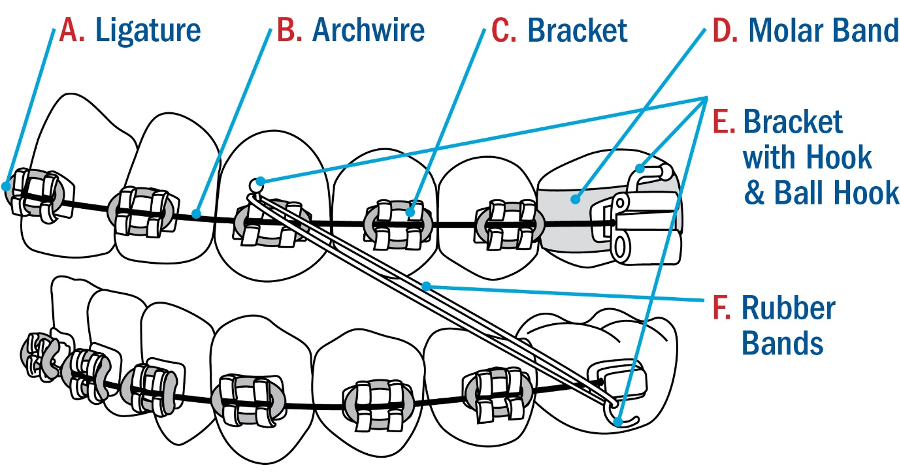What to Consider During Orthodontic Treatment with Braces
What to Consider During Orthodontic Treatment with Braces




Eş, Baba, Ortodontist...
Yüzücü ve Doğa Tutkunu!

Eş, Baba, Ortodontist...
Yüzücü ve Doğa Tutkunu!
What to Consider During Orthodontic Treatment with Braces
Your orthodontist will evaluate the progress of your treatment and the health of your teeth and gums during your visits. According to the ideal schedule, you will have appointments every 6-8 weeks with new generation self-ligating braces. For traditional braces, you should schedule appointments every 4 weeks. This is important to save your valuable time with fewer clinical sessions.
Each patient has unique specific problems, so the treatment duration varies for each individual. Your orthodontist, Assoc. Prof. Dr Fatih KAHRAMAN, will provide an estimated treatment duration before starting your treatment.
If your bracket breaks, your wire loosens, or your clear aligner breaks or gets lost, please contact us as soon as possible. (Phone: 0212 570 00 33, WhatsApp: 0544 570 00 33). A broken bracket cannot apply the correct force to your tooth, which may unfortunately prolong your treatment.
We do not recommend it. Unless your treatment is in the functional phase, you can have your braces removed, but we strongly advise against it. This is because without stability, your teeth and jaw will quickly revert to their original positions, extending your treatment duration. Additionally, removing all brackets can deform them, making reuse impossible. Continuing your treatment will require a new set of brackets, resulting in additional costs.
It is important to continue regular general care visits to your dentist in addition to seeing your orthodontist during orthodontic treatment. Your dentist will continue to perform routine dental check-ups and professional cleanings. During orthodontic treatment, you should visit your dentist every 4-6 months, or more frequently if necessary.
When your brackets are first applied, they may cause temporary discomfort. Maintaining ideal oral hygiene can prevent small sores that may appear inside the lips and cheeks during the adjustment period in the first few days, resulting in a completely painless process. If small sores caused by bracket irritation appear after starting orthodontic treatment, they will typically heal within a week with good brushing and will not recur. Eventually, you will likely forget that you are even wearing braces.
After each orthodontic check-up session, you may feel mild pain due to new movement plans and dental movements, regardless of the treatment type. This is a completely physiological event and nothing to worry about. If you have a high pain threshold, you may not feel any pain at all. You can also use the “orthodontic wax” provided by your orthodontist, which is applied over the brackets, to help you go through this process with minimal or no pain.
The appointment to place the orthodontic brackets on your teeth and the final removal appointment will take approximately 45-90 minutes. Other sessions will average around 20 minutes. Clear aligner check-ups usually take less than 5 minutes. Our DentMax Dental Clinics will do their best to accommodate your schedule and minimise disruption to your school or work.
As with all orthodontic treatments, you should brush your teeth consistently for 2 minutes after consuming food, using an interdental brush to reach between the brackets and behind the wires. Brushing is successful when there are no food residues left around the brackets and wires.
Recommendation: Carry a travel toothbrush and a small tube of toothpaste with you for brushing when you are away from home. If you are unable to brush your teeth after snacking, at least rinse your mouth with water to remove some food particles and drink residues.
We recommend using fluoride toothpaste approved by the UK Department of Health, without any whitening agents.
You should use dental floss at least once a day during your orthodontic treatment with braces.
Using dental floss is crucial for maintaining oral health and ensuring the success of your orthodontic treatment. Simply using a toothbrush is not enough for oral hygiene when wearing braces. Dental floss helps reach the areas your brush alone cannot and provides a thorough cleaning. Plaque is the enemy. Remember, dental plaque is the main cause of disease processes in the teeth and gums.
Brushing and using dental floss removes bacterial plaque and food debris, keeping your teeth and gums clean. If plaque and food debris are left on your teeth and around your braces, it can lead to cavities, swollen and bleeding gums, and severe bad breath. It can also cause unwanted permanent white marks. Good oral hygiene helps minimise your treatment duration and contributes to a healthy outcome.
Use the toothbrush that is most suitable for you. Make sure to brush at least 4 times a day, with each session lasting 2 minutes! Change your toothbrush or electric toothbrush head every 2 months. If the bristles are frayed, change it sooner.
Here are three useful tools to help with oral hygiene:
Interdental Brush for Cleaning Braces: These are excellent for removing plaque and food particles stuck between your teeth and braces. They clean the areas your toothbrush cannot reach and minimise plaque formation.
Oral Irrigator (Water Flosser) for Cleaning Braces: It cleans deep below the gum line and fights harmful bacteria. It gently removes food particles, providing targeted cleaning. An oral irrigator is a great complement to daily brushing and is ideal for anyone looking to improve gum health. It helps remove food debris effectively.
Fluoride Mouth Rinse: Using fluoride mouth rinses strengthens tooth enamel and helps prevent permanent white marks. For more effective brushing, dip your interdental brush into a cap of fluoride mouth rinse and clean between your teeth. Using fluoride mouth rinse instead of plain water in your oral irrigator helps fight bacteria between teeth, reducing and preventing plaque formation, which is the main cause of gum disease.
A healthy diet supports your body as it undergoes biological changes during orthodontic treatment. It is encouraged to enjoy a variety of healthy, easy-to-chew foods. Soups, stews, casseroles, pasta, scrambled eggs, and smoothies are good options. Enjoy fresh fruits like apples and pears, but slice them instead of biting into them. Similarly, sandwiches and pizzas are fine, but cut them into bite-sized pieces. Cut the corn off the cob before serving.
If you are planning to use removable functional appliances, you can remove them while eating and then brush and replace them, continuing your usual diet without any restrictions.
Young people with braces should preferably avoid acidic drinks such as cola, Fanta, and soda. Instead of biting into hard foods (such as bagels, toast, pizza, lahmacun, wraps, sandwiches, burgers, meat), cut them into small pieces and soften them with non-acidic drinks. Large-seeded foods (such as plums and olives) should be consumed after removing the seeds.
Occasionally, problems with braces or aligners may arise during orthodontic treatment. In such cases, contacting your orthodontist or scheduling an unforeseen visit may be necessary.
Whether you need to be seen by your orthodontist will depend on what has happened to your appliance. Contact your orthodontist's office to explain the problem and determine if a visit is necessary.
If you notice a loose bracket, a wire out of place, or experience unusual discomfort, inform your orthodontist.
Keep materials on hand to address potential issues. Here are six suggestions:
Yes. However, discuss with your orthodontist the type of mouthguard you should wear.

Erstellen Sie schnell Ihren Termin in 5 Schritten
Ihre Anfrage wurde erhalten. Wir werden uns so schnell wie möglich mit Ihnen in Verbindung setzen.